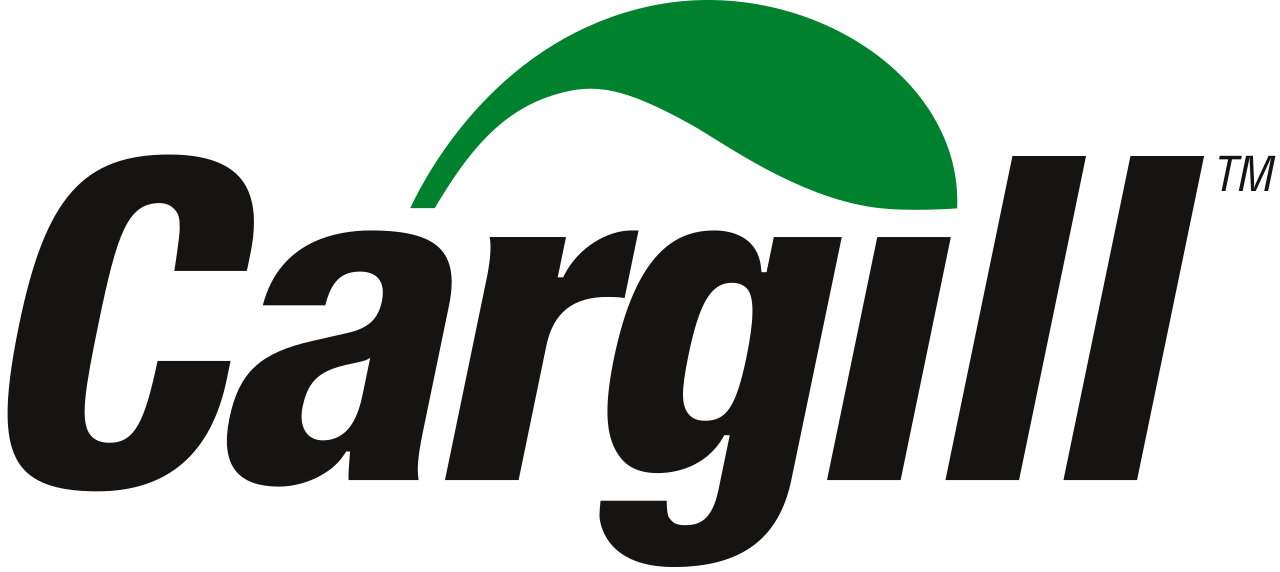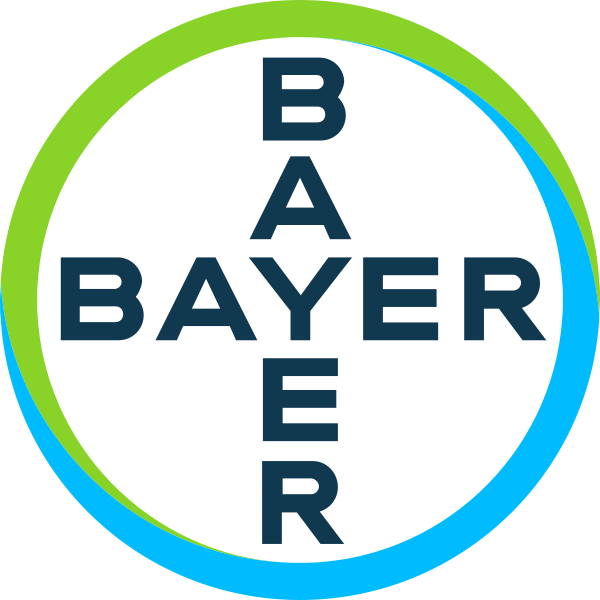Global Nematicides Market, By Crop, By Type, By Mode of Action, By Form, By Region & Segmental Insights Trends and Forecast, 2024 – 2034
- Industry: Agriculture
- Report ID: TNR-110-1221
- Number of Pages: 420
- Table/Charts : Yes
- July, 2024
- Base Year : 2024
- No. of Companies : 10+
- No. of Countries : 29
- Views : 10128
- Covid Impact Covered: Yes
- War Impact Covered: Yes
- Formats : PDF, Excel, PPT
Nematicides are a type of chemical pesticide used to kill or manage nematodes, which are microscopic, worm-like organisms that can cause damage to plants by feeding on their roots, stems, leaves, or flowers. These chemicals are commonly used in agriculture to protect crops from nematode infestations that can lead to significant yield losses. The nematicides market is experiencing robust growth, driven by increasing agricultural productivity demands and rising incidences of nematode infestations. Key trends include a shift towards bio-based nematicides, spurred by environmental regulations and consumer preference for organic produce. Technological advancements in integrated pest management (IPM) and precision agriculture further enhance market prospects.
The growing global population and consequent food security concerns necessitate efficient crop protection solutions, bolstering nematicide adoption. Additionally, significant R&D investments by key players aim to develop sustainable and highly effective nematicide formulations. The Asia-Pacific region, with its extensive agricultural base and increasing awareness about crop health, is projected to lead market growth, reinforcing the global expansion of nematicides. In Terms of Revenue, the Global Nematicides Market was Worth US$ 1.68 Bn in 2023, Anticipated to Witness CAGR of 6.3% During 2024 – 2034.

Trends in the Global Nematicides Market
- Shift Towards Bio-based Nematicides: As environmental regulations tighten and consumer awareness of sustainable agriculture grows, there is a significant move away from synthetic chemicals. Bio-based nematicides, derived from natural sources such as beneficial bacteria, fungi, and plant extracts, are gaining popularity due to their lower environmental impact and reduced risk of resistance development in nematodes. These products offer a safer alternative for farmers seeking to manage nematode infestations without compromising soil health or biodiversity. Companies are investing heavily in R&D to develop and commercialize effective bio-nematicides, aligning with the global trend towards greener agricultural practices and organic farming.
- Integration of Advanced Technologies in Nematicide Application: Precision agriculture tools, such as GPS-guided equipment, drones, and soil sensors, enable targeted application of nematicides, optimizing their effectiveness while minimizing usage and environmental impact. These technologies allow for precise monitoring and management of nematode populations, leading to more efficient pest control strategies. Additionally, innovations in formulation technologies, such as controlled-release and microencapsulation, enhance the delivery and longevity of nematicides in the soil. The adoption of these advanced technologies not only improves crop protection but also supports sustainable farming practices, making them increasingly appealing to modern agricultural operations.
Vegetables have captured a substantial share of the global nematicides market, driven by their high economic value and susceptibility to nematode infestations. As demand for fresh produce increases globally, farmers are under pressure to maximize yield and quality, necessitating effective nematode management solutions. The intensive cultivation of vegetables, often in monoculture systems, makes them particularly vulnerable to nematode damage, leading to significant economic losses. Consequently, vegetable growers are investing more in nematicides to protect their crops. Additionally, the rise in greenhouse and organic farming practices further propels the demand for both chemical and bio-based nematicides, ensuring healthy and profitable vegetable production.
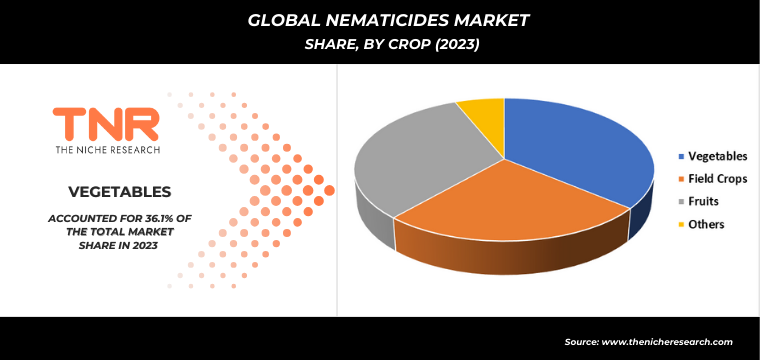
In 2023, bio-based segment by type category has emerged as the second-largest leading segment in the global nematicides market. This growth is attributed to the increasing demand for sustainable and environmentally friendly agricultural practices. Bio-based nematicides, derived from natural sources such as microorganisms and plant extracts, offer a safer alternative to traditional chemical nematicides, reducing environmental impact and enhancing soil health. Regulatory support for organic farming and rising consumer preference for organic produce further boost this segment. Additionally, advancements in biotechnology and increased R&D investments have led to the development of highly effective bio-based nematicides, solidifying their position in the market.
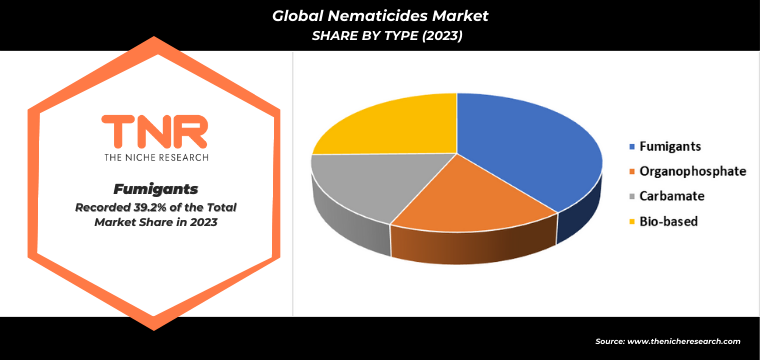
By mode of action, contact segment dominated the global nematicides market and is expanding with a CAGR of 4.7% over the forecast timeline. Contact nematicides, which kill nematodes upon direct contact, are favored for their immediate and effective results in controlling nematode populations. Their popularity is driven by the need for quick action in protecting high-value crops from nematode damage. Additionally, improvements in formulation technologies have enhanced the efficacy and application convenience of contact nematicides. The rising adoption of these solutions in intensive farming practices and the increasing demand for high-yield crop protection are key factors contributing to the robust growth of this market segment.
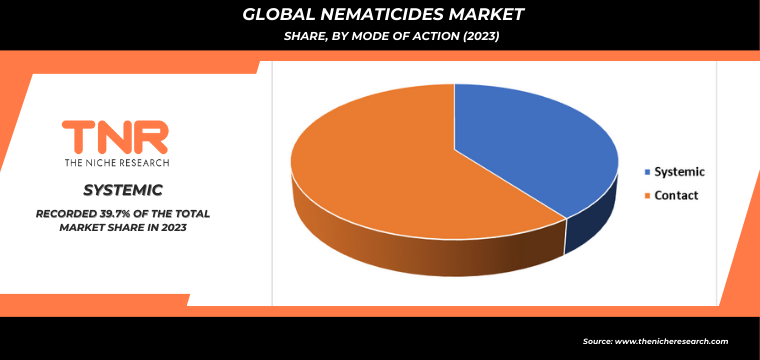
Solid segment by form is set to be fastest growing segment in the global nematicides market with a revenue share of 31.3% in 2023. Solid nematicides, available as granules, pellets, and powders, offer several advantages, including ease of application, reduced drift, and prolonged residual activity in the soil. These characteristics make them highly effective for protecting crops over extended periods. The growing preference for solid formulations is driven by their compatibility with various application methods, such as broadcast spreading and soil incorporation. Additionally, innovations in formulation technologies are enhancing the efficiency and environmental safety of solid nematicides, further propelling their market growth.
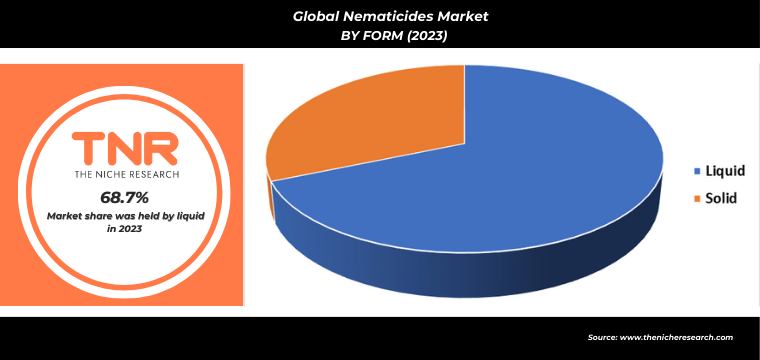
In 2023, North America solidified its position as the leading region in the nematicides market, driven by advanced agricultural practices and a high demand for efficient pest management solutions. The region’s well-established agricultural infrastructure and strong focus on crop yield optimization have spurred the adoption of nematicides. Additionally, the increasing prevalence of nematode infestations in key crops such as corn, soybeans, and vegetables has heightened the need for effective control measures. Supportive regulatory frameworks and significant R&D investments in innovative and sustainable nematicide products further contribute to market growth. North America’s commitment to precision agriculture and sustainable farming practices continues to drive the expansion of the nematicides market.

Competitive Landscape
Some of the players operating in the nematicides market are
- American Vanguard Corporation
- BASF SE
- Bayer AG
- Corteva Agriscience
- FMC Corporation
- Marrone Bio Innovations
- Nufarm Limited
- Sumitomo Chemical Co., Ltd.
- Syngenta
- UPL Limited
- Other Industry Participants
Global Nematicides Market Scope
| Report Specifications | Details |
| Market Revenue in 2023 | US$ 1.68 Bn |
| Market Size Forecast by 2034 | US$ 3.29 Bn |
| Growth Rate (CAGR) | 6.3% |
| Historic Data | 2016 – 2022 |
| Base Year for Estimation | 2023 |
| Forecast Period | 2024 – 2034 |
| Report Inclusions | Market Size & Estimates, Market Dynamics, Competitive Scenario, Trends, Growth Factors, Market Determinants, Key Investment Segmentation, Product/Service/Solutions Benchmarking |
| Segments Covered | By Crop, By Type, By Mode of Action, By Form, By Region |
| Regions Covered | North America, Europe, Asia Pacific, Middle East & Africa, Latin America |
| Countries Covered | U.S., Canada, Mexico, Rest of North America, France, The UK, Spain, Germany, Italy, Nordic Countries (Denmark, Finland, Iceland, Sweden, Norway), Benelux Union (Belgium, The Netherlands, Luxembourg), Rest of Europe, China, Japan, India, New Zealand, Australia, South Korea, Southeast Asia (Indonesia, Thailand, Malaysia, Singapore, Rest of Southeast Asia), Rest of Asia Pacific, Saudi Arabia, UAE, Egypt, Kuwait, South Africa, Rest of Middle East & Africa, Brazil, Argentina, Rest of Latin America |
| Key Players | American Vanguard Corporation, BASF SE, Bayer AG, Corteva Agriscience, FMC Corporation, Marrone Bio Innovations, Nufarm Limited, Sumitomo Chemical Co., Ltd., Syngenta, UPL Limited |
| Customization Scope | Customization allows for the inclusion/modification of content pertaining to geographical regions, countries, and specific market segments. |
| Pricing & Procurement Options | Explore purchase options tailored to your specific research requirements |
| Contact Details | Consult With Our Expert
Japan (Toll-Free): +81 663-386-8111 South Korea (Toll-Free): +82-808- 703-126 Saudi Arabia (Toll-Free): +966 800-850-1643 United Kingdom: +44 753-710-5080 United States: +1 302-232-5106 E-mail: askanexpert@thenicheresearch.com
|
Global Nematicides Market
By Crop
- Vegetables
- Field Crops
- Fruits
- Others
By Type
- Fumigants
- Organophosphate
- Carbamate
- Bio-based
By Mode of Action
- Systemic
- Contact
By Form
- Liquid
- Emulsifiable concentrates
- Suspensions
- Solid
- Granules
- Powders
By Region
- North America (U.S., Canada, Mexico, Rest of North America)
- Europe (France, The UK, Spain, Germany, Italy, Nordic Countries (Denmark, Finland, Iceland, Sweden, Norway), Benelux Union (Belgium, The Netherlands, Luxembourg), Rest of Europe)
- Asia Pacific (China, Japan, India, New Zealand, Australia, South Korea, Southeast Asia (Indonesia, Thailand, Malaysia, Singapore, Rest of Southeast Asia), Rest of Asia Pacific)
- Middle East & Africa (Saudi Arabia, UAE, Egypt, Kuwait, South Africa, Rest of Middle East & Africa)
- Latin America (Brazil, Argentina, Rest of Latin America)
Report Layout:
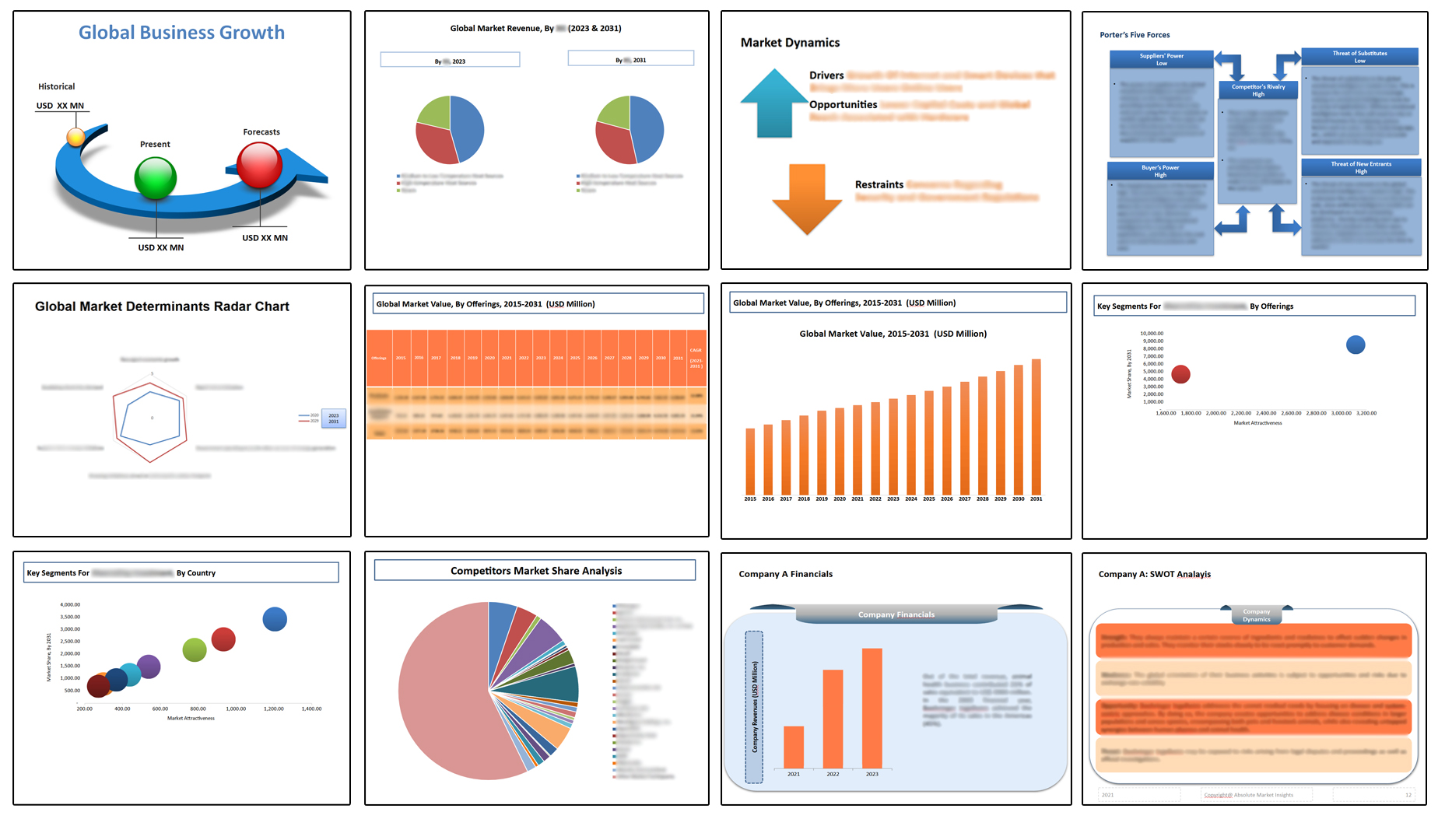
Table of Contents
Note: This ToC is tentative and can be changed according to the research study conducted during the course of report completion.
**Exclusive for Multi-User and Enterprise User.
Global Nematicides Market
By Crop
- Vegetables
- Field Crops
- Fruits
- Others
By Type
- Fumigants
- Organophosphate
- Carbamate
- Bio-based
By Mode of Action
- Systemic
- Contact
By Form
- Liquid
- Emulsifiable concentrates
- Suspensions
- Solid
- Granules
- Powders
By Region
- North America (U.S., Canada, Mexico, Rest of North America)
- Europe (France, The UK, Spain, Germany, Italy, Nordic Countries (Denmark, Finland, Iceland, Sweden, Norway), Benelux Union (Belgium, The Netherlands, Luxembourg), Rest of Europe)
- Asia Pacific (China, Japan, India, New Zealand, Australia, South Korea, Southeast Asia (Indonesia, Thailand, Malaysia, Singapore, Rest of Southeast Asia), Rest of Asia Pacific)
- Middle East & Africa (Saudi Arabia, UAE, Egypt, Kuwait, South Africa, Rest of Middle East & Africa)
- Latin America (Brazil, Argentina, Rest of Latin America)
The Niche Research approach encompasses both primary and secondary research methods to provide comprehensive insights. While primary research is the cornerstone of our studies, we also incorporate secondary research sources such as company annual reports, premium industry databases, press releases, industry journals, and white papers.
Within our primary research, we actively engage with various industry stakeholders, conducting paid interviews and surveys. Our meticulous analysis extends to every market participant in major countries, allowing us to thoroughly examine their portfolios, calculate market shares, and segment revenues.
Our data collection primarily focuses on individual countries within our research scope, enabling us to estimate regional market sizes. Typically, we employ a bottom-up approach, meticulously tracking trends in different countries. We analyze growth drivers, constraints, technological innovations, and opportunities for each country, ultimately arriving at regional figures.Our process begins by examining the growth prospects of each country. Building upon these insights, we project growth and trends for the entire region. Finally, we utilize our proprietary model to refine estimations and forecasts.
Our data validation standards are integral to ensuring the reliability and accuracy of our research findings. Here’s a breakdown of our data validation processes and the stakeholders we engage with during our primary research:
- Supply Side Analysis: We initiate a supply side analysis by directly contacting market participants, through telephonic interviews and questionnaires containing both open-ended and close-ended questions. We gather information on their portfolios, segment revenues, developments, and growth strategies.
- Demand Side Analysis: To gain insights into adoption trends and consumer preferences, we reach out to target customers and users (non-vendors). This information forms a vital part of the qualitative analysis section of our reports, covering market dynamics, adoption trends, consumer behavior, spending patterns, and other related aspects.
- Consultant Insights: We tap into the expertise of our partner consultants from around the world to obtain their unique viewpoints and perspectives. Their insights contribute to a well-rounded understanding of the markets under investigation.
- In-House Validation: To ensure data accuracy and reliability, we conduct cross-validation of data points and information through our in-house team of consultants and utilize advanced data modeling tools for thorough verification.
The forecasts we provide are based on a comprehensive assessment of various factors, including:
- Market Trends and Past Performance (Last Five Years): We accurately analyze market trends and performance data from preceding five years to identify historical patterns and understand the market’s evolution.
- Historical Performance and Growth of Market Participants: We assess the historical performance and growth trajectories of key market participants. This analysis provides insights into the competitive landscape and individual company strategies.
- Market Determinants Impact Analysis (Next Eight Years): We conduct a rigorous analysis of the factors that are projected to influence the market over the next eight years. This includes assessing both internal and external determinants that can shape market dynamics.
- Drivers and Challenges for the Forecast Period:Identify the factors expected to drive market growth during the forecast period, as well as the challenges that the industry may face. This analysis aids in deriving an accurate growth rate projection.
- New Acquisitions, Collaborations, or Partnerships: We keep a close watch on any new acquisitions, collaborations, or partnerships within the industry. These developments can have a significant impact on market dynamics and competitiveness.
- Macro and Micro Factors Analysis:A thorough examination of both macro-level factors (e.g., economic trends, regulatory changes) and micro-level factors (e.g., technological advancements, consumer preferences) that may influence the market during the forecast period.
- End-User Sentiment Analysis: To understand the market from the end-user perspective, we conduct sentiment analysis. This involves assessing the sentiment, preferences, and feedback of the end-users, which can provide valuable insights into market trends.
- Perspective of Primary Participants: Insights gathered directly from primary research participants play a crucial role in shaping our forecasts. Their perspectives and experiences provide valuable qualitative data.
- Year-on-Year Growth Trend: We utilize a year-on-year growth trend based on historical market growth and expected future trends. This helps in formulating our growth projections, aligning them with the market’s historical performance.
Research process adopted by TNR involves multiple stages, including data collection, validation, quality checks, and presentation. It’s crucial that the data and information we provide add value to your existing market understanding and expertise. We have also established partnerships with business consulting, research, and survey organizations across regions and globally to collaborate on regional analysis and data validation, ensuring the highest level of accuracy and reliability in our reports.
